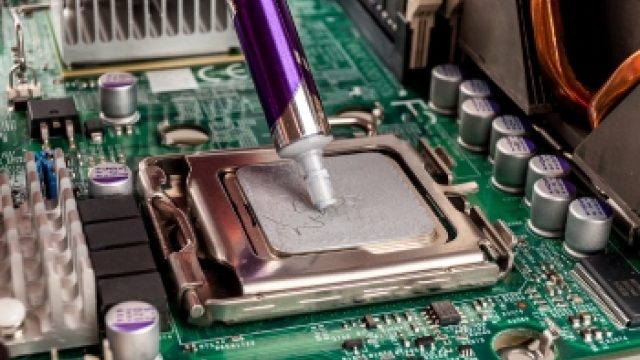Thermal paste is a critical yet often overlooked component in a computer system that plays a vital role in ensuring efficient heat transfer between the central processing unit (CPU) or graphics processing unit (GPU) and the heat sink.
In this comprehensive article, we will delve into the factors influencing the lifespan of thermal paste, the signs of deteriorating thermal paste, and the best practices for its replacement. Let’s embark on this journey of thermal knowledge.
Understanding Thermal Paste
Thermal paste, also known as thermal grease or thermal compound, is a viscous substance applied between the CPU/GPU and the heat sink to enhance thermal conductivity.
Its primary function is to fill in microscopic gaps and imperfections on the mating surfaces, ensuring maximum contact and heat transfer efficiency.
There is a variety of thermal paste formulations available, each catering to different needs. Some are based on ceramic compounds, while others use metal-based fillers.
The choice of thermal paste largely depends on the specific requirements of your system and your thermal performance goals.
Factors Affecting Thermal Paste Lifespan
The quality of thermal paste plays a significant role in determining its lifespan. High-quality pastes generally have better thermal stability and can endure higher temperatures for more extended periods.
The more frequently your CPU/GPU operates, the faster the thermal paste will degrade. Systems that are under heavy load or overclocked are more likely to experience thermal paste deterioration.
Higher ambient temperatures put more stress on thermal paste, accelerating its breakdown. Additionally, the efficiency of your system’s cooling solution directly affects how well the thermal paste can maintain optimal performance.
Overclocking and prolonged heavy-load activities generate more heat, demanding better thermal paste performance. Over time, such activities can contribute to the degradation of thermal paste.
Signs of Deteriorating Thermal Paste
One of the most apparent signs of deteriorating thermal paste is an increase in CPU/GPU temperatures during regular use or gaming sessions. If you notice higher than usual temperatures, it might be time for a thermal paste replacement.
As thermal paste loses its effectiveness, the CPU/GPU can become unstable, leading to system crashes or unexpected shutdowns, especially under heavy loads.
Inadequate heat transfer due to aging thermal paste can cause your system’s fans to work harder to maintain acceptable temperatures. This might result in increased fan noise, which can be a sign of thermal issues.
Manufacturer Recommendations
CPU/GPU manufacturers often provide guidelines regarding the recommended replacement intervals for thermal paste. It’s essential to check their recommendations and follow them for optimal performance and warranty adherence.
Different thermal paste brands might have varying guidelines for replacement intervals. Always refer to the product’s manual or the manufacturer’s website for precise instructions.
Related Article: How to Check If CPU Cooler Is Mounted Properly
Average Lifespan of Thermal Paste
On average, thermal paste can last anywhere from 2 to 4 years. However, this can vary depending on the quality of the paste, usage patterns, and environmental factors.
Real-world usage, such as heavy gaming, video rendering, or running resource-intensive applications, can shorten the thermal paste’s lifespan. Conversely, more moderate usage might extend its longevity.
Regular Maintenance vs. Performance Optimization
While regular thermal paste replacement is essential for maintaining optimal system temperatures, it’s crucial to strike a balance between maintenance and the pursuit of peak performance.
A fresh application of thermal paste can significantly improve heat transfer and lower temperatures, positively impacting the overall performance and longevity of your system.
Thermal Paste Application Techniques
There are several methods to apply thermal paste, including the dot method, spread method, line method, and X method. Each technique has its advantages and disadvantages.
Applying the correct amount of thermal paste is crucial for optimal performance. Too little or too much can hinder heat transfer. Finding the right balance is essential.
Proper Cleaning and Preparation
Thoroughly cleaning the old thermal paste from the CPU/GPU surface is vital before applying new paste. We’ll guide you through the steps to ensure a clean and smooth surface.
Using the right cleaning materials and techniques is essential to ensure that no residue or contaminants remain on the CPU/GPU surface.
Applying New Thermal Paste
Selecting the appropriate thermal paste for your system’s needs involves considering factors such as thermal conductivity, curing time, and ease of application.
We’ll provide a detailed step-by-step guide on how to apply thermal paste correctly, maximizing its effectiveness and ensuring even coverage.
Related Article: CPU Thermal Pad vs Paste: Maximizing Cooling Efficiency
Stress Testing and Temperature Monitoring
After applying new thermal paste, stress testing your CPU/GPU is essential to ensure stability and assess the effectiveness of the new paste.
We’ll recommend some reliable temperature monitoring tools to keep track of your system’s thermal performance.
Advanced Users: Thermal Paste Alternatives
Advanced users might consider alternative thermal paste solutions, each with its unique advantages and risks. We’ll explore conductive and non-conductive options.
While alternative solutions may offer specific benefits, they can also pose certain risks that users should be aware of before making a decision.
Real-World Experiences and Case Studies
Real users share their experiences with thermal paste replacement, highlighting the impact on system performance and temperatures.
We’ll analyze the data from the case studies to gain insights into the effects of thermal paste replacement on system performance and temperatures.
FAQs About How Often Should Thermal Paste Be Changed
How long does thermal paste usually last?
Thermal paste typically lasts between 2 to 5 years, depending on the quality and application.
Over time, it may degrade and lose its effectiveness, resulting in increased temperatures and potential heat-related issues.
How do I know if I need to replace my thermal paste?
If you notice higher-than-usual CPU or GPU temperatures, frequent overheating, or erratic performance, it might be time to replace the thermal paste.
Regular maintenance and reapplication can help optimize your system’s cooling efficiency.
How often should I change thermal paste GPU?
For GPUs, it’s generally recommended to replace the thermal paste every 2 to 3 years. However, this can vary based on usage and environmental factors.
Monitoring temperatures and conducting regular maintenance will give you a better idea of when to reapply.
Does thermal paste ever go bad?
Yes, thermal paste can go bad over time. Factors like exposure to heat and air can cause it to dry out or harden, leading to reduced thermal conductivity.
Keeping the thermal paste stored in a cool and sealed environment can help prolong its shelf life.
Is it OK using thermal paste every month?
Frequent reapplication of thermal paste is unnecessary and not recommended. Thermal paste is designed to maintain its effectiveness for extended periods.
Applying it every month could introduce air bubbles or impurities, negatively affecting heat dissipation.
Can I use 4-year-old thermal paste?
Using 4-year-old thermal paste is not ideal but may still work if it has been stored correctly and is not dried out.
However, for optimal performance, it’s best to use fresh thermal paste or replace the old one with a new application.
Does changing thermal paste improve performance?
Replacing old or poorly performing thermal paste can improve performance by reducing temperatures and preventing thermal throttling.
However, the degree of improvement will vary depending on the original condition of the thermal paste and the system’s overall cooling setup.
How often should you repaste your CPU?
For CPUs, it’s recommended to repaste every 2 to 4 years. However, this timeframe may change based on factors like the type of thermal paste used, the CPU’s heat output, and the computer’s usage patterns.
Regularly monitoring temperatures can help determine when it’s time to repaste.
What happens if you never replace thermal paste?
If you never replace the thermal paste, its effectiveness will degrade over time.
This can lead to higher operating temperatures, increased risk of thermal throttling, and potentially even permanent damage to your CPU or GPU due to prolonged exposure to excessive heat.
What happens if thermal paste dries?
When thermal paste dries out, it loses its ability to facilitate efficient heat transfer between the CPU/GPU and the heatsink.
As a result, temperatures will rise, leading to decreased performance and a higher risk of overheating. It is crucial to replace dried thermal paste to maintain optimal cooling and performance.
Final Thoughts About How Often Should Thermal Paste Be Changed
In conclusion, the frequency of thermal paste replacement depends on various factors such as the quality of the paste, system usage, and environmental conditions.
Generally, for CPUs and GPUs, it is recommended to change the thermal paste every 2 to 5 years. Regular monitoring of temperatures and system performance can provide valuable insights into the paste’s condition and when a reapplication is needed.
While it may be tempting to change the thermal paste frequently, doing so is unnecessary and can potentially introduce issues.
By adhering to the recommended replacement intervals, users can ensure optimal cooling efficiency and extend the lifespan of their valuable hardware.


